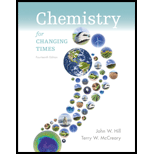
Concept explainers
a.
Interpretation:
Lewis symbol for phosphorus should be written.
Concept Introduction: Lewis symbol is representation of an atom to show the number of valence electrons present in it. Some of the electrons involved in bonding and some remains as lone pair. The electrons are represented by dots surrounding the symbol of atom of the element.
b.
Interpretation:
Lewis symbol for fluorine should be written.
Concept Introduction: Lewis symbol is representation of an atom to show the number of valence electrons present in it. Some of the electrons involved in bonding and some remains as lone pair. The electrons are represented by dots surrounding the symbol of atom of the element.
c.
Interpretation:
Lewis symbol for boron should be written.
Concept Introduction: Lewis symbol is representation of an atom to show the number of valence electrons present in it. Some of the electrons involved in bonding and some remains as lone pair. The electrons are represented by dots surrounding the symbol of atom of the element.
a.
Interpretation:
“Write Lewis symbols of phosphorus.” should be explained
Concept introduction:
- Valence electron: The electrons which are present in the outer most energy level are known as valance electron. This can be calculated by the group number of the element. Generally the group number is same as the valance electrons of any elements.
- Lewis symbol represent the valence electrons of an atom.
b.
Interpretation:
“Write Lewis symbols of fluorine.” should be explained
Concept introduction:
- Valence electron: The electrons which are present in the outer most energy level are known as valance electron. This can be calculated by the group number of the element. Generally the group number is same as the valance electrons of any elements.
- Lewis symbol represent the valence electrons of an atom.
C.
Interpretation:
“Write Lewis symbols of Boron.” should be explained
Concept introduction:
- Valence electron: The electrons which are present in the outer most energy level are known as valance electron. This can be calculated by the group number of the element. Generally the group number is same as the valance electrons of any elements.
- Lewis symbol represent the valence electrons of an atom.
Want to see the full answer?
Check out a sample textbook solution
Chapter 4 Solutions
Chemistry For Changing Times (14th Edition)
- The emission data in cps displayed in Table 1 is reported to two decimal places by the chemist. However, the instrument output is shown in Table 2. Table 2. Iron emission from ICP-AES Sample Blank Standard Emission, cps 579.503252562 9308340.13122 Unknown Sample 343.232365741 Did the chemist make the correct choice in how they choose to display the data up in Table 1? Choose the best explanation from the choices below. No. Since the instrument calculates 12 digits for all values, they should all be kept and not truncated. Doing so would eliminate significant information. No. Since the instrument calculates 5 decimal places for the standard, all of the values should be limited to the same number. The other decimal places are not significant for the blank and unknown sample. Yes. The way Saman made the standards was limited by the 250-mL volumetric flask. This glassware can report values to 2 decimal places, and this establishes our number of significant figures. Yes. Instrumental data…arrow_forwardSteps and explanation pleasearrow_forwardSteps and explanation to undertand concepts.arrow_forward
- Nonearrow_forward7. Draw a curved arrow mechanism for the following reaction. HO cat. HCI OH in dioxane with 4A molecular sievesarrow_forwardTry: Convert the given 3D perspective structure to Newman projection about C2 - C3 bond (C2 carbon in the front). Also, show Newman projection of other possible staggered conformers and circle the most stable conformation. Use the template shown. F H3C Br Harrow_forward
- Nonearrow_forward16. Consider the probability distribution p(x) = ax", 0 ≤ x ≤ 1 for a positive integer n. A. Derive an expression for the constant a, to normalize p(x). B. Compute the average (x) as a function of n. C. Compute σ2 = (x²) - (x)², the variance of x, as a function of n.arrow_forward451. Use the diffusion model from lecture that showed the likelihood of mixing occurring in a lattice model with eight lattice sites: Case Left Right A B C Permeable Barrier → and show that with 2V lattice sites on each side of the permeable barrier and a total of 2V white particles and 2V black particles, that perfect de-mixing (all one color on each side of the barrier) becomes increasingly unlikely as V increases.arrow_forward
 ChemistryChemistryISBN:9781305957404Author:Steven S. Zumdahl, Susan A. Zumdahl, Donald J. DeCostePublisher:Cengage Learning
ChemistryChemistryISBN:9781305957404Author:Steven S. Zumdahl, Susan A. Zumdahl, Donald J. DeCostePublisher:Cengage Learning ChemistryChemistryISBN:9781259911156Author:Raymond Chang Dr., Jason Overby ProfessorPublisher:McGraw-Hill Education
ChemistryChemistryISBN:9781259911156Author:Raymond Chang Dr., Jason Overby ProfessorPublisher:McGraw-Hill Education Principles of Instrumental AnalysisChemistryISBN:9781305577213Author:Douglas A. Skoog, F. James Holler, Stanley R. CrouchPublisher:Cengage Learning
Principles of Instrumental AnalysisChemistryISBN:9781305577213Author:Douglas A. Skoog, F. James Holler, Stanley R. CrouchPublisher:Cengage Learning Organic ChemistryChemistryISBN:9780078021558Author:Janice Gorzynski Smith Dr.Publisher:McGraw-Hill Education
Organic ChemistryChemistryISBN:9780078021558Author:Janice Gorzynski Smith Dr.Publisher:McGraw-Hill Education Chemistry: Principles and ReactionsChemistryISBN:9781305079373Author:William L. Masterton, Cecile N. HurleyPublisher:Cengage Learning
Chemistry: Principles and ReactionsChemistryISBN:9781305079373Author:William L. Masterton, Cecile N. HurleyPublisher:Cengage Learning Elementary Principles of Chemical Processes, Bind...ChemistryISBN:9781118431221Author:Richard M. Felder, Ronald W. Rousseau, Lisa G. BullardPublisher:WILEY
Elementary Principles of Chemical Processes, Bind...ChemistryISBN:9781118431221Author:Richard M. Felder, Ronald W. Rousseau, Lisa G. BullardPublisher:WILEY





